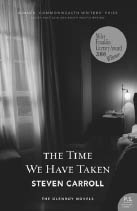The Inspiration
BEFORE HE BEGAN WRITING The Art of the Engine Driver, the first novel featuring the characters of Michael, Vic and Rita, Steven Carroll had a dream. He dreamed he was a child walking with his parents along his boyhood street in suburban Glenroy, on the edge of Melbourne. They were on their way to a neighbourhood party. When he woke he began to wonder whether it was possible to write a novel about the sensations of growing up in the new Australian suburbs in the Menzies era.
‘the ordinary things can sometimes bring some sense of the sublime into life’
There are other parallels with his own life in the novels. ‘My dad,’ Carroll says, ‘was an engine driver and I grew up with lots of descriptions of engine driving. He trained in steam and graduated to diesel. The drivers were so proud of what they did. They talked about it as writers might talk about writing. It was admirable. It gave their lives integrity and meaning.’ Although he admits he draws heavily on childhood memories of his father in the two novels, he is quick to add that the character certainly went its own way. ‘The aim of writing is not to replicate reality but to reinvent it,’ he says.
‘I started writing The Gift of Speed during the Tampa crisis, when I was really, really angry with the whole country. I thought I would write a really angry book. But I found that in going back to this particular summer of 1960–61, which was an iconic summer, I was discovering us at our best, as distinct from our worst. It occurred to me that it was through cricket that our whole society actually opened up. There were half a million people in the street to say goodbye to the West Indies side in a time of the White Australia Policy and when Aborigines couldn’t even vote. It’s true to say, “They were the West Indies, they were going back anyway”, but the thing is we didn’t have to react the way we did … and I find it hard to imagine it happening now…
‘I suspect that what happens with Michael, with his dream of the perfect ball or why he’s so obsessed with it, is that for many people this is the only way that a sense of the sublime actually enters ordinary living. I loathe golf, but it may be someone teeing off on the golf course and feeling the perfect impact, or it may be something else, but the ordinary things can sometimes bring some sense of the sublime into life … In lots of ways I’m writing about cricket but I’m also writing about writing, and what you’ve got in Michael, to an extent, is the artistic temperament, the loner, the one who goes by himself and doesn’t troop off in a gang…
‘The idea was to write a book that is about speed on different thematic levels. In many ways The Art of the Engine Driver is about speed too, and The Gift of Speed is just thematically the extension of that. I wanted to write a book about people obsessed with speed, living in a world of speed, but to write it in the present tense, and to portray this experience almost in slow motion, so that the people who are living these lives, caught up in almost a constant and frantic state of becoming, might miss the “moments” of their lives, but the book itself doesn’t. And neither, through the book, does the reader.
‘what you’ve got in Michael, to an extent, is the artistic temperament, the loner, the one who goes by himself’
‘Speed operates in lots of different ways in the book but one is actually the suburb itself, and it’s a phase of history [when] the country seemed to go into fast-forward from about 1946 onwards, and these suburbs just bloomed and sprung up.’ 
Have You Read…?
The Time We Have Taken
One summer morning in 1970, Peter van Rijn, proprietor of the television and wireless shop, pronounces his Melbourne suburb one hundred years old.
That same morning, Rita is awakened by a dream of her husband’s snores, yet it is years since Vic moved north. Their son, Michael, has left for the city, and is entering the awkward terrain of first love.
As the suburb prepares to celebrate progress, Michael’s friend Mulligan is commissioned to paint a mural of the area’s history. But what vision of the past will his painting reveal?
Meanwhile, Rita’s sometime friend Mrs Webster confronts the mystery of her husband’s death. And Michael discovers that innocence can only be sustained for so long.
The Time We Have Taken is both a meditation on the rhythms of suburban life and a luminous exploration of public and private reckoning during a time of radical change.
